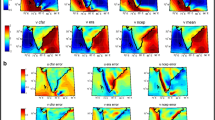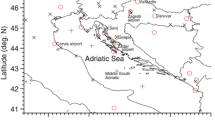Abstract
Climate models are increasingly being used to force dynamical wind wave models in order to assess the potential climate change-driven variations in wave climate. In this study, an ensemble of wave model simulations have been used to assess the ability of climate model winds to reproduce the present-day (1981–2000) mean wave climate and its seasonal variability for the southeast coast of Australia. Surface wind forcing was obtained from three dynamically downscaled Coupled Model Intercomparison Project (CMIP-3) global climate model (GCM) simulations (CSIRO Mk3.5, GFDLcm2.0 and GFDLcm2.1). The downscaling was performed using CSIRO’s cubic conformal atmospheric model (CCAM) over the Australian region at approximately 60-km resolution. The wind climates derived from the CCAM downscaled GCMs were assessed against observations (QuikSCAT and NCEP Re-analysis 2 (NRA-2) reanalyses) over the 1981–2000 period and were found to exhibit both bias in mean wind conditions (climate bias) as well as bias in the variance of wind conditions (variability bias). Comparison of the modelled wave climate with over 20 years of wave data from six wave buoys in the study area indicates that direct forcing of the wave models with uncorrected CCAM winds result in suboptimal wave hindcast. CCAM winds were subsequently adjusted for climate and variability bias using a bivariate quantile adjustment which corrects both directional wind components to align in distribution to the NRA-2 winds. Forcing of the wave models with bias-adjusted winds leads to a significant improvement of the hindcast mean annual wave climate and its seasonal variability. However, bias adjustment of the CCAM winds does not improve the ability of the model to reproduce the storm wave climate. This is likely due to a combination of storm systems tracking too quickly through the wave generation zone and the performance of the NRA-2 winds used as a benchmark in this study.









Similar content being viewed by others
References
Alves J-HGM (2006) Numerical modelling of ocean swell contributions to the global wind wave climate. Ocean Model 11(1–2):98–122
Andrade C, Pires HO, Taborda R, Freitas MC (2007) Projecting future changes in wave climate and coastal response in Portugal by the end of the 21st century. J Coast Res 50:263–257
Booij N, Ris RC, Holthuijsen LH (1999) A third generation wave model for coastal regions. Part 1: Model description and validation. J Geophys Res 104(C4):7649–7666
Caires S, Swail VR, Wang XL (2006) Projection and analysis of extreme wave climate. J Clim 19:5581–5605
CERSAT (2002) QuikSCAT Scatterometer mean wind field products user manual. Centre ERS d'Archivage et de Traitement. Report Ref.: C2-MUT-W-03-IF. 48p. ftp://ftp.ifremer.fr/ifremer/cersat/documentation/gridded/mwf-quikscat/mwf_vol2.pdf
Chapman WL, Walsh JE (1996) Arctic and Southern Ocean sea ice concentrations. National Snow and Ice Data Center/World Data Center for Glaciology, Boulder, CO. Digital media
Christensen JH, Hewitson B, Busuioc A, Chen A, Gao X, Held I, Jones R, Kwon W-T, et al. (2007) Regional climate projections. Climate Change 2007: the physical science basis. In: Solomon S, Qin D, Manning M, Chen Z, Marquis M, Avery KB, Tignor M, Miller HL (eds) Contribution of Working Group I to the Fourth Assessment Report of the Intergovernmental Panel on Climate Change. Cambridge University Press, Cambridge, pp 847–940
Coelho C, Silva R, Veloso-Gomes F, Taveira-Pinto F (2009) Potential effects of climate change on northwest Portuguese coastal zones. ICES J Mar Sci 66:1497–1507
Collins M, An S, Cai W, Ganachaud A, Guilyardi E, Jin F, Jochum M, Lengaigne M, Power S, Timmermann A, Vecchi G, Wittenberg A (2010) The impact of global warming on the tropical Pacific Ocean and El Niño. Nat Geosci 3:391–397. doi:10.1038/NGEO868
Corney SP, Katzfey J, Grose MR, Bennett JC, White CJ, Holz GK, Gaynor SM, Bindoff NL (2010) Climate futures for Tasmania: modelling technical report. Antarctic Climate and Ecosystems Cooperative Research Centre, Hobart, Tasmania, Australia
Cowell PJ, Roy PS, Jones RA (1995) Simulation of large scale coastal change using a morphological behaviour model. Mar Geol 126:45–61
Debernard JB, Roed LP (2008) Future wind, wave and storm surge climate in the Northern Seas: a revisit. Tellus 60A:427–438
Debernard JB, Saetra O, Roed LP (2002) Future wind, wave and storm surge climate in the Northern Seas. Climatic Res 23:39–49
Goodwin ID (2005) A mid-shelf wave direction climatology for south-eastern Australia, and its relationship to the El Niño–Southern Oscillation since 1877 AD. Int J Climatol 25:1715–1729
Goodwin ID, Stables MA, Olley JM (2006) Wave climate, sand budget and shoreline alignment evolution of the Iluka–Woody Bay sand barrier, northern New South Wales, Australia, since 3000 yr BP. Mar Geol 226(1–2):127–144
Grabemann I, Weisse R (2008) Climate change impact on extreme wave conditions in the North Sea: an ensemble study. Ocean Dyn 58:199–212. doi:10.1007/s10236-008-0141-x
Grose MR, Barnes-Keoghan I, Corney SP, White CI, Holz GK, Bennett JC, Gaynor SM, Bindoff NL (2010) Climate futures for Tasmania: general climate impacts technical report. Antarctic Climate and Ecosystems Cooperative Research Centre. Hobart, Tasmania. Australia. http://www.climatechange.tas.gov.au/__data/assets/pdf_file/0011/134210/CFT_-_General_Climate_Impacts_Technical_Report_-_WEB_lo-res_content_hi-res_cover_-101003.pdf
Harley MD, Turner IL, Short AD, Ranasinghe R (2010a) Assessment and integration of conventional RTK-GPS and image-derived beach survey methods for saily to decadal coastal monitoring. Coast Eng 58(2):194–205
Harley MD, Turner IL, Short AD, Ranasinghe R (2010b) Interannual variability and controls of the Sydney wave climate. Int J Climatol 30:1322–1335. doi:10.1002/joc.1962
Hemer MA, Church JA, Hunter JR (2007) Waves and climate change on the Australian coast. J Coastal Res SI50:432–437
Hemer MA, Simmonds I, Keay K (2008) A classification of wave generation characteristics during large wave events on the Southern Australian margin. Continental Shelf Res 28:634–652. doi:10.1016/j.csr.2007.12.004
Hemer MA, Church JA, Hunter JR (2010) Variability and trends in the directional wave climate of the Southern Hemisphere. Int J Climatol 30:475–491. doi:10.1002/joc.1900
Hemer MA, McInnes K, Ranasinghe R (2011) Exploring uncertainty in regional east Australian wave climate projections. Int J Climatol (in press)
Jones ISF, Toba Y (2001) Wind stress over the ocean. Cambridge University Press, Cambridge, 326 pp
Kanamitsu M, Ebisuzaki W, Woollen J, Yang S-K, Hnilo JJ, Fiorino M, Potter GL (2002) NCEP-DOE AMIP-II reanalysis. Bul Atmos Met Soc 83:1631–1643
Katzfey JJ, McInnes KL (1996) GCM simulations of eastern Australian cut-off lows. J Climate 9:2337–2355
Katzfey JJ, McGregor J, Nguyen K, Thatcher M (2009) Dynamical downscaling techniques: impacts on regional climate change signals. Proceedings of the 18th World IMACS/MODSIM Congress, Cairns, Australia, 13–17 July 2009, pp 3942–3947
Kirchhofer W (1973) Classification of European 500-mb patterns. Arbeitsbericht der Schweizerischen Meteorologischen Zentralanstalt No. 43, Geneva
Lionello P, Cogo S, Galati MB, Sanna A (2008) The Mediterranean surface wave climate inferred from future scenario simulations. Glob Planet Chang 63:152–162
Lord D, Kulmar M (2000) The 1974 storms revisited: 25 years experience in ocean wave measurement along the south-east Australian coast. In: Edge BL (ed) Proceedings of the 27th International Conference on Coastal Engineering. ASCE, Sydney, Australia, pp 559–572
McGregor JL (2005) C-CAM: geometric aspects and dynamical formulation. CSIRO marine and atmospheric research technical report 70. http://www.cmar.csiro.au/e-print/open/mcgregor_2005a.pdf
McGregor JL, Dix MR (2008) An updated description of the conformal-cubic atmospheric model. In: Hamilton K, Ohfuchi W (eds) High resolution simulation of the atmosphere and ocean. Springer, Berlin, pp 51–76
Meehl GA, Covey C, Delworth T, Latif M, McAvaney B, Mitchell JFB, Stouffer RJ, Taylor KE (2007) The WCRP CMIP3 multimodel dataset: a new era in climate change research. Bull Am Meteor Soc 88:1383–1394
Nicholls RJ, Wong PP, Burkett VR, Codignotto JO, Hay JE, McLean RF, Ragoonaden S, Woodroffe CD (2007) Coastal systems and low-lying areas. Climate change 2007: impacts, adaptation and vulnerability. In: Parry ML, Canziani OF, Palutikof JP, van der Linden PJ, Hanson CE (eds) Contribution of Working Group II to the Fourth Assessment Report of the Intergovernmental Panel on Climate Change. Cambridge University Press, Cambridge, UK, pp 315–356
Pezza AB, Durrant T, Simmonds I, Smith I (2008) Southern Hemisphere synoptic behavior in extreme phases of SAM, ENSO, sea ice extent and southern Australia rainfall. J Clim 21:5566–5584
Ranasinghe R, McLoughlin R, Short A, Symonds G (2004) The Southern Oscillation Index, wave climate, and beach rotation. Mar Geol 204:273–287
Ris RC, Holthuijsen LH, Booij N (1999) A third-generation wave model for coastal regions. 2. Verification. J Geophys Res 104(C4):7667–7681
Rogers WE, Hwang PA, Wang DW (2002) Investigation of wave growth and decay in the SWAN model: three regional scale applications. J Phys Oceanog 33(2):366–389
Schmidt F (1977) Variable fine mesh in spectral global models. Beitr Phys Atmos 50:211–217
Serra YL, Cronin MF, Kiladis GN (2007) Sub-seasonal variance of surface meteorological parameteris in buoy observations and reanalyses. Geophys Res Lett 34:L12708. doi:10.1029/2007GL029506
Short AD, Treneman NL (1992) Wave climate of the Sydney region, an energetic and highly variable ocean wave regime. Aust J Mar Freshwater Res 43:765–791
Short AD, Trembanis AC, Turner IL (2000) Beach oscillations, rotation and the Southern Oscillation, Narrabeen Beach, Australia. Proceedings of the International Coastal Engineering Conference, Sydney, pp 2439–2452
Sterl A, Caires S (2005) Climatology, variability and extrema of ocean waves: the web-based KNMI/ERA-40 wave atlas. Int J Climatol 25:963–977. doi:10.1002/joc.1175
Tolman H (2002) User manual and system documentation of WAVEWATCH-III, version 2.22. NOAA/NWS/NCEP/MMAB Technical Note 222, 133 pp. http://polar.ncep.noaa.gov/mmab/papers/tn222/MMAB_222.pdf
Trenberth K, Dole R, Xue Y, Onogi K, Dee R, Balmaseda M, Bosilovich M, Schubert S, Large W (2010) Atmospheric reanalyses: a major resource for ocean product development and modeling. In: Hall J, Harrison DE, Stammer D (eds) Proceedings of the “OceanObs’09: Sustained Ocean Observations and Information for Society” Conference (vol 2), Venice, Italy, 21–25 September 2009. ESA Publication WPP-306. doi:10.5270/OceanObs09.cwp.90
Wang XL, Swail VR (2006) Climate change signal and uncertainty in projections of ocean wave heights. Clim Dyn 26:109–126
Wang XL, Swail VR, Cox A (2010) Dynamical versus statistical downscaling methods for ocean wave heights. Int J Climatol 30(3):317–332. doi:10.1002/joc.1899
Winterfeldt J, Geyer B, Weisse R (2011) Using QuikSCAT in the added value assessment of dynamically downscaled wind speed. Int J Climatol 31(7):1028–1039
Wood AW, Maurer EP, Kumar A, Lettenmaier DP (2002) Long-range experimental hydrologic forecasting for the eastern United States. J Geophys Res 107:D20–D4429. doi:10.1029/2001JDD000659
Acknowledgements
This manuscript is a contribution from the Climate Variability and Change Program of the Centre for Australian Weather and Climate Research: A partnership between CSIRO and the Bureau of Meteorology and the CSIRO Climate Adaptation Flagship. The authors are grateful for financial support for the research from the Coastal Vulnerability Program of the Australian Government Department of Climate Change and Energy Efficiency. We acknowledge the NSW State Government Manly Hydraulics Institute and the Queensland State Government Environmental Protection Agency for the use of their waverider buoy data, NSW Dept of Environment, Climate Change and Water for their in-kind contributions, and NCEP-DOE for the open availability of the NRA-2 database. M. Hemer would also like to acknowledge the support and useful conversations had with Prof. Marcel Stive and Drs. Nico Booij and Leo Holthuijsen during an extended research visit to TUDelft. We would also like to thank Drs. Jim Gunson, Ivan Haigh and Ralf Weisse for their constructive reviews on earlier versions of this manuscript.
Author information
Authors and Affiliations
Corresponding author
Additional information
Responsible Editor: Chari Pattiaratchi
This article is part of the Topical Collection on Physics of Estuaries and Coastal Seas 2010
Rights and permissions
About this article
Cite this article
Hemer, M.A., McInnes, K.L. & Ranasinghe, R. Climate and variability bias adjustment of climate model-derived winds for a southeast Australian dynamical wave model. Ocean Dynamics 62, 87–104 (2012). https://doi.org/10.1007/s10236-011-0486-4
Received:
Accepted:
Published:
Issue Date:
DOI: https://doi.org/10.1007/s10236-011-0486-4




